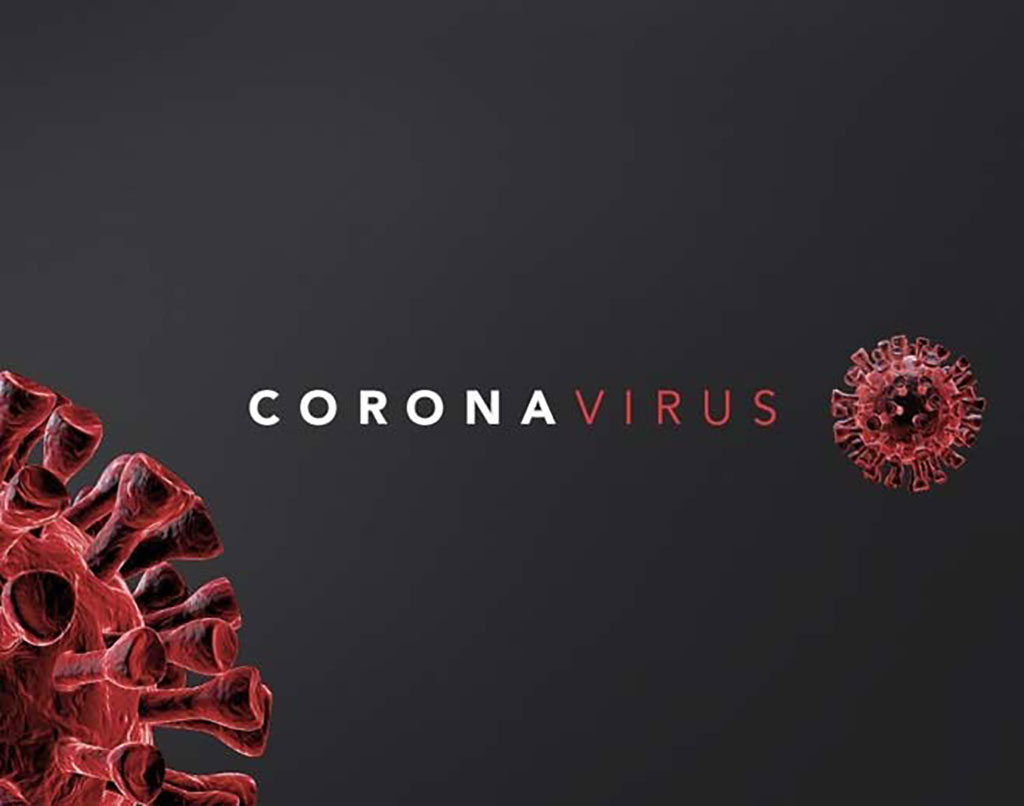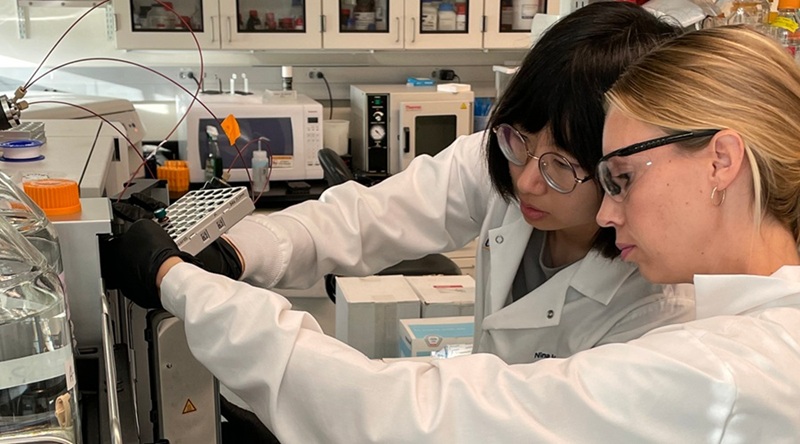Non-Invasive Skin Swab Samples Enough to Quickly Detect COVID-19, Finds New Study
|
By LabMedica International staff writers Posted on 17 Mar 2021 |

Illustration
Non-invasive skin swab samples are enough to quickly detect COVID-19, according to findings of a new study.
In the study, researchers at the University of Surrey (Guildford, Surrey, UK), collected sebum samples from 67 hospitalized patients - 30 who had tested positive for COVID-19 and 37 who had tested negative. The samples were collected by gently swabbing a skin area rich in sebum - an oily, waxy substance produced by the body's sebaceous glands - such as the face, neck or back. The researchers analyzed the samples by using liquid chromatography mass spectrometry and a statistical modeling technique called Partial Least Squares - Discriminant Analysis to differentiate between the COVID-19 positive and negative samples.
The team then found that patients with a positive COVID-19 test had lower lipid levels - or dyslipidemia - than their counterparts with a negative test. The accuracy of the study’s results increased further when medication and additional health conditions were controlled.
"Unfortunately, the specter of future pandemics is firmly on the top of the agenda for the scientific community. Our study suggests that we may be able to use non-invasive means to test for diseases such as COVID-19 in the future - a development which I am sure will be welcomed by all," said Dr. Melanie Bailey, co-author of the study from the University of Surrey.
"COVID-19 damages many areas of metabolism. In this work, we show that the skin lipidome can be added to the list, which could have implications for the skin’s barrier function, as well as being a detectable symptom of the disease itself," added Matt Spick, co-author of the study from the University of Surrey.
"Investigating new methods of diagnosis and surveillance in a new disease such as COVID-19 that has had such a devastating effect on the world is vital. Sebum sampling is a simple, non-invasive method that shows promise for both diagnostics and monitoring of the disease in both a healthcare and a non-healthcare setting," noted Dr. George Evetts, Consultant in Anesthesia & Intensive Care Medicine at Frimley Park Hospital.
Related Links:
University of Surrey
In the study, researchers at the University of Surrey (Guildford, Surrey, UK), collected sebum samples from 67 hospitalized patients - 30 who had tested positive for COVID-19 and 37 who had tested negative. The samples were collected by gently swabbing a skin area rich in sebum - an oily, waxy substance produced by the body's sebaceous glands - such as the face, neck or back. The researchers analyzed the samples by using liquid chromatography mass spectrometry and a statistical modeling technique called Partial Least Squares - Discriminant Analysis to differentiate between the COVID-19 positive and negative samples.
The team then found that patients with a positive COVID-19 test had lower lipid levels - or dyslipidemia - than their counterparts with a negative test. The accuracy of the study’s results increased further when medication and additional health conditions were controlled.
"Unfortunately, the specter of future pandemics is firmly on the top of the agenda for the scientific community. Our study suggests that we may be able to use non-invasive means to test for diseases such as COVID-19 in the future - a development which I am sure will be welcomed by all," said Dr. Melanie Bailey, co-author of the study from the University of Surrey.
"COVID-19 damages many areas of metabolism. In this work, we show that the skin lipidome can be added to the list, which could have implications for the skin’s barrier function, as well as being a detectable symptom of the disease itself," added Matt Spick, co-author of the study from the University of Surrey.
"Investigating new methods of diagnosis and surveillance in a new disease such as COVID-19 that has had such a devastating effect on the world is vital. Sebum sampling is a simple, non-invasive method that shows promise for both diagnostics and monitoring of the disease in both a healthcare and a non-healthcare setting," noted Dr. George Evetts, Consultant in Anesthesia & Intensive Care Medicine at Frimley Park Hospital.
Related Links:
University of Surrey
Latest COVID-19 News
- New Immunosensor Paves Way to Rapid POC Testing for COVID-19 and Emerging Infectious Diseases
- Long COVID Etiologies Found in Acute Infection Blood Samples
- Novel Device Detects COVID-19 Antibodies in Five Minutes
- CRISPR-Powered COVID-19 Test Detects SARS-CoV-2 in 30 Minutes Using Gene Scissors
- Gut Microbiome Dysbiosis Linked to COVID-19
- Novel SARS CoV-2 Rapid Antigen Test Validated for Diagnostic Accuracy
- New COVID + Flu + R.S.V. Test to Help Prepare for `Tripledemic`
- AI Takes Guesswork Out Of Lateral Flow Testing
- Fastest Ever SARS-CoV-2 Antigen Test Designed for Non-Invasive COVID-19 Testing in Any Setting
- Rapid Antigen Tests Detect Omicron, Delta SARS-CoV-2 Variants
- Health Care Professionals Showed Increased Interest in POC Technologies During Pandemic, Finds Study
- Set Up Reserve Lab Capacity Now for Faster Response to Next Pandemic, Say Researchers
- Blood Test Performed During Initial Infection Predicts Long COVID Risk
- Low-Cost COVID-19 Testing Platform Combines Sensitivity of PCR and Speed of Antigen Tests
- Finger-Prick Blood Test Identifies Immunity to COVID-19
- Quick Test Kit Determines Immunity Against COVID-19 and Its Variants
Channels
Clinical Chemistry
view channel
Online Tool Detects Drug Exposure Directly from Patient Samples
Doctors often rely on patient interviews and medical records to determine what medications a person has taken, but this information is frequently incomplete. People may forget drugs they used, take over-the-counter... Read more
Chemical Imaging Probe Could Track and Treat Prostate Cancer
Prostate cancer remains a leading cause of illness and death among men, with many patients eventually developing resistance to standard hormone-blocking therapies. These drugs often lose effectiveness... Read moreMolecular Diagnostics
view channel
Ovarian Cancer Assay Outperforms Traditional Tests in Early Disease Detection
Globally, ovarian cancer is one of the deadliest cancers affecting women. Traditionally, early diagnosis of ovarian cancer has been challenging. Many ovarian cancers are diagnosed only after they have... Read more
Ultrasensitive Method Detects Low-Frequency Cancer Mutations
Liquid biopsy has emerged as a promising approach for cancer detection and treatment monitoring, although its clinical impact has been limited by the extremely low levels of tumor-derived DNA circulating in blood.... Read moreHematology
view channel
MRD Tests Could Predict Survival in Leukemia Patients
Acute myeloid leukemia is an aggressive blood cancer that disrupts normal blood cell production and often relapses even after intensive treatment. Clinicians currently lack early, reliable markers to predict... Read more
Platelet Activity Blood Test in Middle Age Could Identify Early Alzheimer’s Risk
Early detection of Alzheimer’s disease remains one of the biggest unmet needs in neurology, particularly because the biological changes underlying the disorder begin decades before memory symptoms appear.... Read more
Microvesicles Measurement Could Detect Vascular Injury in Sickle Cell Disease Patients
Assessing disease severity in sickle cell disease (SCD) remains challenging, especially when trying to predict hemolysis, vascular injury, and risk of complications such as vaso-occlusive crises.... Read more
ADLM’s New Coagulation Testing Guidance to Improve Care for Patients on Blood Thinners
Direct oral anticoagulants (DOACs) are one of the most common types of blood thinners. Patients take them to prevent a host of complications that could arise from blood clotting, including stroke, deep... Read moreImmunology
view channel
Routine Blood Test Can Predict Who Benefits Most from CAR T-Cell Therapy
CAR T-cell therapy has transformed treatment for patients with relapsed or treatment-resistant non-Hodgkin lymphoma, but many patients eventually relapse despite an initial response. Clinicians currently... Read more
New Test Distinguishes Vaccine-Induced False Positives from Active HIV Infection
Since HIV was identified in 1983, more than 91 million people have contracted the virus, and over 44 million have died from related causes. Today, nearly 40 million individuals worldwide live with HIV-1,... Read more
Gene Signature Test Predicts Response to Key Breast Cancer Treatment
DK4/6 inhibitors paired with hormone therapy have become a cornerstone treatment for advanced HR+/HER2– breast cancer, slowing tumor growth by blocking key proteins that drive cell division.... Read more
Chip Captures Cancer Cells from Blood to Help Select Right Breast Cancer Treatment
Ductal carcinoma in situ (DCIS) accounts for about a quarter of all breast cancer cases and generally carries a good prognosis. This non-invasive form of the disease may or may not become life-threatening.... Read moreMicrobiology
view channel
Blood-Based Diagnostic Method Could Identify Pediatric LRTIs
Lower-respiratory tract infections (LRTIs) are a leading cause of illness and death worldwide, and pneumonia is the leading infectious cause of death in children under five, claiming the lives of over... Read more
Rapid Diagnostic Test Matches Gold Standard for Sepsis Detection
Sepsis kills 11 million people worldwide every year and generates massive healthcare costs. In the USA and Europe alone, sepsis accounts for USD 100 billion in annual hospitalization expenses.... Read moreRapid POC Tuberculosis Test Provides Results Within 15 Minutes
Tuberculosis remains one of the world’s deadliest infectious diseases, and reducing new cases depends on identifying individuals with latent infection before it progresses. Current diagnostic tools often... Read more
Rapid Assay Identifies Bloodstream Infection Pathogens Directly from Patient Samples
Bloodstream infections in sepsis progress quickly and demand rapid, precise diagnosis. Current blood-culture methods often take one to five days to identify the pathogen, leaving clinicians to treat blindly... Read morePathology
view channel
Rapid Low-Cost Tests Can Prevent Child Deaths from Contaminated Medicinal Syrups
Medicinal syrups contaminated with toxic chemicals have caused the deaths of hundreds of children worldwide, exposing a critical gap in how these products are tested before reaching patients.... Read more
Tumor Signals in Saliva and Blood Enable Non-Invasive Monitoring of Head and Neck Cancer
Head and neck cancers are among the most aggressive malignancies worldwide, with nearly 900,000 new cases diagnosed each year. Monitoring these cancers for recurrence or relapse typically relies on tissue... Read more
Common Health Issues Can Influence New Blood Tests for Alzheimer’s Disease
Blood-based tests for Alzheimer’s disease are transforming diagnosis by offering a simpler alternative to spinal taps and brain imaging. However, many people evaluated at memory clinics also live with... Read more
Blood Test Formula Identifies Chronic Liver Disease Patients with Higher Cancer Risk
Chronic liver disease affects millions worldwide and can progress silently to hepatocellular carcinoma (HCC), one of the deadliest cancers globally. While surveillance guidelines exist for patients with... Read moreTechnology
view channel
Machine Learning Models Diagnose ALS Earlier Through Blood Biomarkers
Amyotrophic lateral sclerosis (ALS) is a rapidly progressive neurodegenerative disease that is notoriously difficult to diagnose in its early stages. Early symptoms often overlap with other neurological... Read more
Artificial Intelligence Model Could Accelerate Rare Disease Diagnosis
Identifying which genetic variants actually cause disease remains one of the biggest challenges in genomic medicine. Each person carries tens of thousands of DNA changes, yet only a few meaningfully alter... Read moreIndustry
view channel
Abbott Acquires Cancer-Screening Company Exact Sciences
Abbott (Abbott Park, IL, USA) has entered into a definitive agreement to acquire Exact Sciences (Madison, WI, USA), enabling it to enter and lead in fast-growing cancer diagnostics segments.... Read more




















